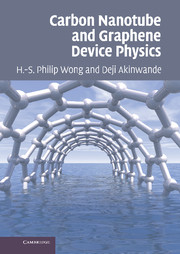Book contents
- Frontmatter
- Contents
- Preface
- 1 Overview of carbon nanotubes
- 2 Electrons in solids: a basic introduction
- 3 Graphene
- 4 Carbon nanotubes
- 5 Carbon nanotube equilibrium properties
- 6 Ideal quantum electrical properties
- 7 Carbon nanotube interconnects
- 8 Carbon nanotube field-effect transistors
- 9 Applications of carbon nanotubes
- Index
6 - Ideal quantum electrical properties
Published online by Cambridge University Press: 05 June 2012
- Frontmatter
- Contents
- Preface
- 1 Overview of carbon nanotubes
- 2 Electrons in solids: a basic introduction
- 3 Graphene
- 4 Carbon nanotubes
- 5 Carbon nanotube equilibrium properties
- 6 Ideal quantum electrical properties
- 7 Carbon nanotube interconnects
- 8 Carbon nanotube field-effect transistors
- 9 Applications of carbon nanotubes
- Index
Summary
It seems that the fundamental idea pertaining to quanta is the impossibility to consider an isolated quantity of energy without associating a particular frequency to it.
Louis de Broglie (postulated electron waves)Introduction
The goal of this chapter is to explore the excitation and motion of electron waves under ideal conditions in a metallic conductor. By ideal conditions, we mean that electrons can be excited and transported without any scattering or collision involved. The excitation of electrons can be achieved by applying an external potential to energize the electron waves to oscillate more frequently, which can result in a net electron motion in the presence of a driving electric field, say between two ends of a metallic conductor. It is advisable to commit to memory that the absence of electron scattering is technically called ballistic transport; as such, the metallic conductor in this case would be referred to as a ballistic conductor.
Electrically, the ideal excitation and motion of electrons in low dimensions, such as in 1D space, is manifest in the form of a quantum conductance, quantum capacitance, and kinetic inductance, which represents a different paradigm from our classical electrostatic and magnetostatic ideas. The conductance and inductance reflect the electrical properties of traveling electron waves which lead to charge transport and energy storage, while the quantum capacitance accounts for the intrinsic charge storage that comes about from exciting electrons with an electric potential. In macroscopic bulk metals, the quantum electrical properties are not readily observable or accessible owing to the large number of mobile electrons at hand and the frequent collisions involved.
- Type
- Chapter
- Information
- Carbon Nanotube and Graphene Device Physics , pp. 128 - 156Publisher: Cambridge University PressPrint publication year: 2010



